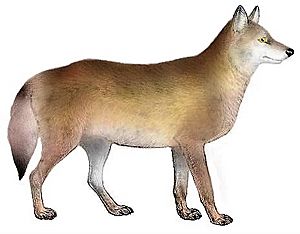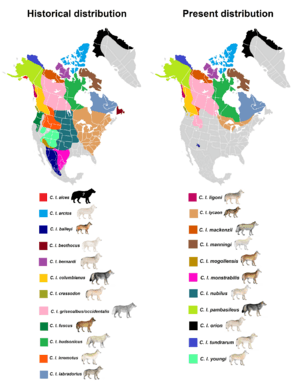Texas wolf facts for kids
Quick facts for kids Texas wolf |
|
|---|---|
 |
|
| Illustration based on a description by Edward Alphonso Goldman | |
| Conservation status | |
|
Extinct (19th century)
|
|
| Scientific classification |
|
| Kingdom: | Animalia |
| Phylum: | Chordata |
| Class: | Mammalia |
| Order: | Carnivora |
| Family: | Canidae |
| Genus: | Canis |
| Species: | |
| Subspecies: |
†C. l. monstrabilis
|
| Trinomial name | |
| Canis lupus monstrabilis Goldman, 1937
|
|
 |
|
| Historical and present range of gray wolf subspecies in North America | |
| Synonyms | |
|
|
The Texas wolf (Canis lupus monstrabilis) was a type of gray wolf that no longer exists. It was different from the Texas red wolf (Canis lupus rufus). This wolf used to live in southern and western Texas and also in northeastern Mexico.
Contents
About the Texas Wolf
The Texas wolf was a unique animal. It was darker in color than other wolves found further north. It also had a special feature: a very arched or curved frontal bone on its head. This bone is part of the skull.
Where Did They Live?
The Texas wolf's home was mainly in the southwestern parts of the United States and nearby Mexico. They roamed across large areas, hunting and living in their natural habitat.
Why Are They Extinct?
The Texas wolf became extinct, meaning it completely disappeared, in the 19th century. This happened because of various reasons, often related to human activities. As people settled more land, the wolves lost their homes and food sources.
How Scientists Knew About Them
Scientists recognized the Texas wolf as a specific type of gray wolf. It was officially named Canis lupus monstrabilis by a scientist named Goldman in 1937. This means it was considered a distinct subspecies within the larger group of gray wolves.
See also
 In Spanish: Lobo Tejano para niños
In Spanish: Lobo Tejano para niños

